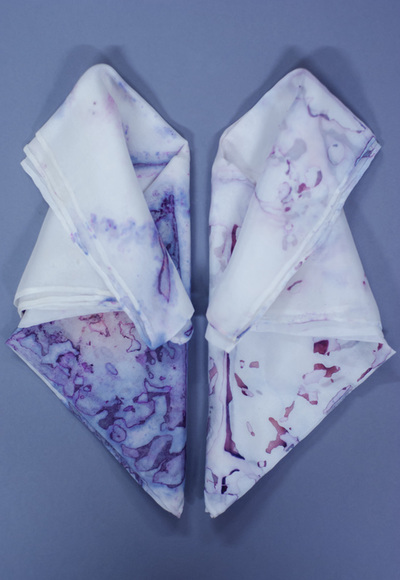| When two different fields meet, we can see the emergence of fascinating projects. Faber Futures is one of them. Natsai Audrey Chieza, based in London, is collaborating with professor John Ward from the University College of London to use pigments produced by bacteria. In Fold, a silk scarf is folded into a petri dish where bacteria will leave and die over seven days. During this period, they will produce some pigments and imprint some patterns and colours onto the fabric. The different colours and patterns are obtained with different kinds of bacteria, coming from the soil surrounding a plant’s roots. In an interview she gave at the Science Library in Dublin, Natsai Audrey Chieza explains that this process could be transferred and adapted to mass manufacturing. With synthetic biology, it would be possible to program specific designs and colours, thus allowing the replication of a given pattern. | |
Bacteria are used a lot with foods, agriculture and drugs among other things. However, it is quite unusual to use them in such a creative project. The goal was to create a new aesthetic language where the laboratory protocol and the design process meet.
This field is called BioDesign, defined by William Myers as:
This field is called BioDesign, defined by William Myers as:
“BioDesign refers specifically to the incorporation of living organisms as essential components in design. […] BioDesign also highlights experiments replacing industrial or mechanical systems with a biological process”
William Meyers
This approach is becoming popular as we realize that the resources around us are not infinite and that we need to find new ways of producing and designing. In his book BioDesign: Nature + Science + Creativity, William Myers gives many examples in art, design, architecture or even advertising. A few pages of this book are available on his website.
This kind of projects are still highly experimental but they introduce new possibilities. If you are interested in that topic, I suggest this article by the NY Times: The Beauty of Bacteria.
Myers, William. Bio design : nature, science, creativity. New York: Museum of Modern Art Distributed in the United States and Canada by ARTBOOK/D.A.P, 2012. Print. ISBN: 9780870708442
This kind of projects are still highly experimental but they introduce new possibilities. If you are interested in that topic, I suggest this article by the NY Times: The Beauty of Bacteria.
Myers, William. Bio design : nature, science, creativity. New York: Museum of Modern Art Distributed in the United States and Canada by ARTBOOK/D.A.P, 2012. Print. ISBN: 9780870708442




